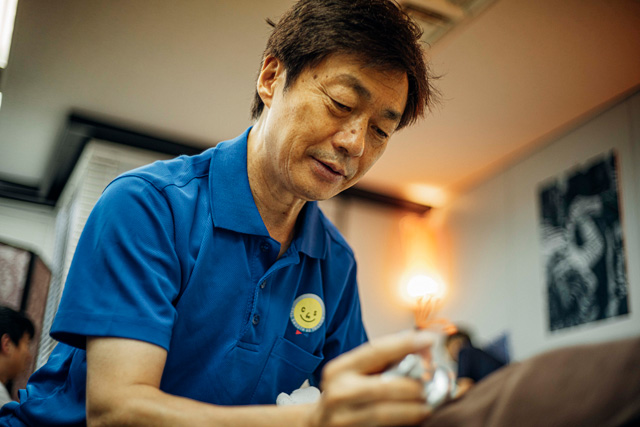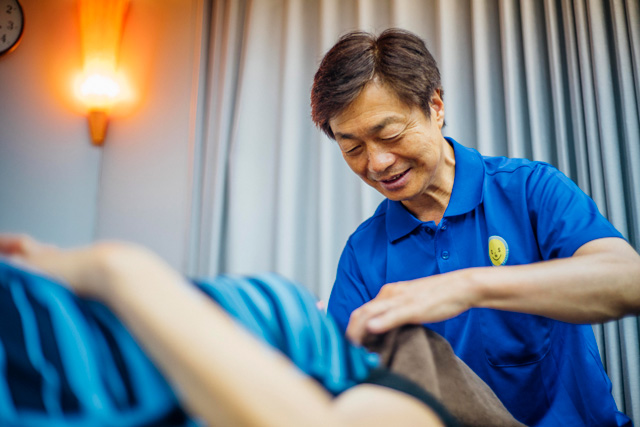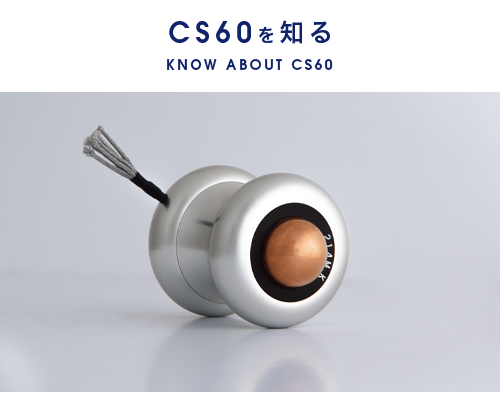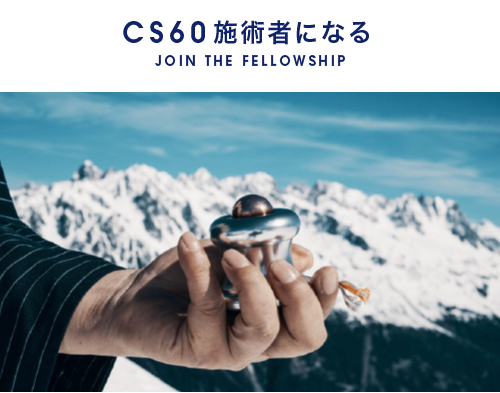
- 2019/09/26
-
Newsletter Vol.25
CS60施術者佐藤忠義さんインタビュー(前編)
Interview with CS60 Practitioner Tadayoshi Sato (Part I)
Praticien du CS60 : l’interview de Monsieur Tadayoshi Sato (première partie) 
CS60には多くの人が関わっています。それぞれどんな想いで、施術を行っているのでしょうか。
それを知るために、「CS60に関わる人たち」のインタビューを行うことにしました。
今回は、本部で働く佐藤忠義さんにお話をうかがいます。
―――――――――――――――――――――――――
―どのようなきっかけでCS60に出会ったのですか?
佐藤:もともと保険の外交員をしていたので、仕事の関係で東京商工会議所の交流会に参加したんです。
そこに西村先生がいらっしゃって、名刺交換させていただきました。
当時、両肩が五十肩ですごく痛かったんです。
寝返りが打てないし、腕が上がらないので上着が自分で着られません。
どの病院に行ってもダメでした。
西村先生に「今五十肩なんです」という話をしたら、鞄からおもむろにCS60を取り出して、会場で施術していただきました(笑)。
―初めて受けた感想はいかがでしたか?
佐藤:第一印象は「痛い!」でした。
私は痛いのが苦手なものですから、長くはできなかったのですが、「これはすごい!」という直感はありました。
西村先生のお人柄に惹かれたこともあり、当時本部のあった「松扇」に何度か通ったら、本当によくなりました。
―それからどうしてフランチャイズに加盟することにしたのですか?
佐藤:私は産業カウンセラーの資格を持っていたので「これはカウンセリングにも生かせるんじゃないか」と思ってレンタルすることにしたのです。
―保険の外交員をしながら、産業カウンセラーの仕事もしていたんですか?
佐藤:会社員ですので、大っぴらにできませんが、知人から相談された時に話を聞いたりしていました。
うつで会社を休んだりしている方は非常に多いですから、復職のお手伝いをしたいと思ってサポートしていたのです。
―なぜ産業カウンセラーの勉強をしようと思ったのですか?
佐藤:45歳の時に心理療法の一つである「フォーカシング」という手法に出会いました。
フォーカシングをすると、いろいろなイメージが膨らんでいき、心の扉が開いていく感覚があったのです。
すごく楽しくて前向きになっていったので、「あっ! これはすごいな」「カウンセリングだけではなく、自分の可能性を広げていくのにもすごく役立つな」と思いました。
その手法を学ぶため、妻と子ども2人連れて、秋田県から東京に出てきたんです。
ハローワークで仕事を探し、外資系の保険会社に入社しました。
当時は知っている人がいなかったので、飛び込み営業をしながら、産業カウンセラーの資格も取得したんです。

―二足のわらじでがんばっていたんですね。
佐藤:ところが、2年間ほとんど土日も休まずに働いたので、自分の体がオーバーヒートしてしまいました。
当時はうつで病院に行くような状態だったのです。
「これでは何のために生きているかわからない。どうやったら自分の状態を改善できるだろうか」とずいぶん考えました。
休むのは当然にしても、それだけではなかなか回復できません。
私が育ったのは白神山地の近くで、今でも熊が出るような田舎です。
そこで過ごした幼少期の感覚を取り戻せればいいなと思ったんですね。
―東京は自然が少ないですが、どうされたのでしょうか?
佐藤:ちょうど、家の近くにこんもりとした森のある公園があったので、日曜日は朝から晩まで1日ずっとそこで寝転がることにしました。
雲の流れや花を見たりしていて自然のエネルギーを感じ、「つらい」という気持ちから抜け出しそうとしたんです。
そうすると、鳥や虫の鳴き声が自分を励ましてくれるような感覚になったんですね。
自然からエネルギーをもらい、五感を使って自分をいやしていったのです。
あのとき「自然に助けてもらった」という気持ちがあるので、カウンセリングも部屋ではなく外で行い、自然の豊かを感じてもらっています。
(つづく)
There are many different people involved with the CS60. But what is it that is going in their heads that is motivating their practice?
We decided to conduct interviews with the people involved in CS60, because we wanted to know the answer to this question.
On this occasion, we came to talk to Tadayoshi Sato at the CS60 HQ.―――――――――――――――――――――――――
– How did you first come to know about the CS60?
Sato: Originally I worked as an insurance salesman, so through my work I attended a networking event at the Tokyo Chamber of Commerce and Industry. I met Dr. Nishimura there and we exchanged business cards.
At the time, I was having a lot of stiffness and pain in both of my shoulders. It was so bad that I couldn’t turn over in bed or raise my arms to dress myself. No hospital that I went to was able to help me.
I mentioned to Dr. Nishimura that I was having shoulder pain, and slowly he drew the CS60 out of his bag, and right there and then on the event floor he treated me. (Laughter.)
– What was your reaction when you were first treated?
Sato: My first reaction was: “that hurts!”
I’m not really good with pain, so I couldn’t take the treatment for too long, but I also got a real feel for how amazing it was.
I was also fairly drawn in by Dr. Nishimura’s personality, and would go to Shosen, which served as the CS60 HQ at the time, where I really got better.
– From there, why did you decide to become a franchisee?
Sato: I hold a qualification as a vocational counselor, and I had the thought that this was something that I could use in my counseling, so I rented out a CS60.
– You were vocational counselor at the same time as you were an insurance salesman?
Sato: Since I was an employee, I couldn’t do it openly, but when people I knew came to me and wanted to discuss something I would hear them out. I knew a lot of people who were taking time off of work because of depression, so I wanted to support them to help them be able to get back to work.
– What motivated you to study to be a vocational counselor?
Sato: When I was 45 I came across a psychotherapy technique known as focusing. Through practicing focusing, I had a variety of images bubble up, and had the sensation of the doors to my mind being flung open. I became really positive and forward-thinking as a result, so I thought: “This is great! This isn’t just for counseling, but also for expanding the horizons of your own possibilities.”
In order to further study focusing I relocated from Akita to Tokyo with my wife and child.
I looked for a job through HelloWork and ended up working at a foreign insurance company. I didn’t have any connections in Tokyo at the time, so I was just doing door-to-door sales, and I got my qualification as a vocational counselor at the same time.
– You had a lot of irons in the fire.
Sato: Yeah, but because of that I basically didn’t have a weekend for two years, and my body was overheating. At the time, I ended up being hospitalized with depression. Most of the time what was going through my head was: “What’s the point of going on like this? What could I possibly do to make things better?”
Obviously I needed rest, but just resting wasn’t enough for me to get better.
I grew up around the Shirakami Mountains. It’s such a rural place that even today they get bears wandering around the area. I had this feeling of wanting to recapture the sense of being a kid there.
– Tokyo doesn’t have much natural environment. What did you do?
Sato: Right near my house there was a park with a thick wooded area, so on Sundays I started going there from morning to evening and spending all day lying on the grass. I would watch the clouds or look at flowers to feel the energy of nature, trying to release the feeling of “stress.”
As I did that, I had the feeling that the cries of the birds and the insects were spurring me on. I was drawing on the energy of nature, and healing myself with the all five senses.
I have the feeling that nature helped me get over my problems at that time, which is why, when I do my counseling, I do it outside, not inside, in order the feel the richness of nature.
(To be continued…)
De nombreuses personnes sont concernées par le CS60. Dans quel but l’utilisent-elles ? Afin d’en savoir plus, nous avons interrogé ces « personnes concernées par le CS60 ».
Cette fois-ci, nous avons interviewé Monsieur Tadayoshi Sato qui travaille au siège du CS60.―――――――――――――――――――――――――
– Comment avez-vous connu le CS60 ?Sato : Comme je travaillais dans une entreprise d’assurance, j’ai eu l’occasion d’assister à une réunion de la chambre de commerce de Tokyo.
Professeur Nishimura y était aussi, ce qui nous a permis d’échanger nos cartes de visite.
À ce moment-là, j’avais mal aux deux épaules parce qu’elles étaient gelées. Je ne pouvais pas changer de côté pendant la nuit. Je ne pouvais même pas mettre ma veste par moi-même car je n’arrivais pas à élever le bras.
Aucun médecin ne m’a guéri.
J’ai expliqué ma situation au professeur Nishimura. Il a sorti tout de suite le CS60 de son sac et m’a soigné sur place (lol).– Qu’avez-vous pensé du CS60 lorsque vous avez reçu des soins pour la première fois ?
Sato : La première impression était « aië ! ».
Comme je ne supporte pas la douleur de façon générale, les soins n’ont pas duré longtemps. Mais j’ai été impressionné par le CS60.
Le Professeur Nishimura étant aussi très agréable, j’ai fréquenté « Shôsen » où se trouvait le siège à l’époque. J’ai d’ailleurs été guéri.– Pourquoi avez-vous décidé de devenir un membre des franchisés ?
Sato : Ayant un diplôme de psychologue de la santé au travail, j’ai pensé que le CS60 servirait au travail de psychologue. C’est pourquoi j’ai décidé de l’emprunter.
– Avez-vous travaillé en tant que psychologue de la santé au travail tout en travaillant dans l’entreprise d’assurance ?
Sato : Comme j’étais un employé, je ne peux pas le dire en public mais j’ai parfois aidé mes amis lorsqu’ils me demandaient conseils.
– Pourquoi avez-vous étudié pour devenir psychologue de la santé au travail ?
Sato : J’ai rencontré lorsque j’avais 45 ans la méthode « forcacing » qui est une psychothérapie. Grâce au « forcacing », j’ai pu développer mon imagination et « ouvrir » mon esprit.
C’était très intéressant et grâce à cette méthode je suis devenu plus positif. Comme elle est géniale, j’ai donc pensé qu’elle pouvait non seulement servir au travail de psychologue mais également m’aider à ouvrir mon champ de possibilités.
Afin d’apprendre la méthode « forcacing », j’ai quitté le département d’Akita pour venir à Tokyo avec ma femme et nos deux enfants.
J’ai cherché un travail au pôle emploi et réussi à trouver un poste dans une entreprise étrangère d’assurance.
Comme je n’ai ni ami ni connaissance à Tokyo, j’ai essayé de trouver de nouveaux clients par moi-même. J’ai en même temps obtenu le diplôme de psychologue de la santé au travail.– Vous avez entretenu deux activités alors.
Sato : Oui, mais ayant travaillé pendant deux ans, même durant les weekends, mon corps a connu une « surchauffe ».
J’ai dû aller à l’hôpital en raison d’une dépression.
Je ne comprenais plus la raison pour laquelle je vivais et je réfléchissais tout le temps à comment je pouvais améliorer ma situation actuelle.
Le repos est évidement important mais ce n’est pas suffisant pour se rétablir.
J’ai grandi à côté des montagnes de Shirakami. Il y a toujours des ours dans ma ville natale qui est située à la compagne.
J’ai voulu de nouveau retrouver, là-bas, les sensations mon enfance.– Il y a peu de nature à Tokyo. Comment avez-vous essayé de la retrouver ?
Sato : Comme il y avait un parc avec une petite forêt près de chez moi, j’y passais tous mes dimanches du matin au soir, je m’allongeais dans le parc.
En regardant le mouvement des nuages et des fleurs, je ressentais l’énergie de la nature, qui m’a aidé à sortir de la dépression.
En faisant comme ça, j’ai eu l’impression que les oiseaux et la voix des insectes m’encourageaient.
La nature m’a offert une énergie. Je me suis soigné en utilisant mes cinq sens.
La nature m’a sauvé. C’est pourquoi je donne conseil à mes clients à l’extérieur au lieu de le faire dans une salle pour qu’ils puissent ressentir la richesse de la nature.(à suivre)
INDEX















